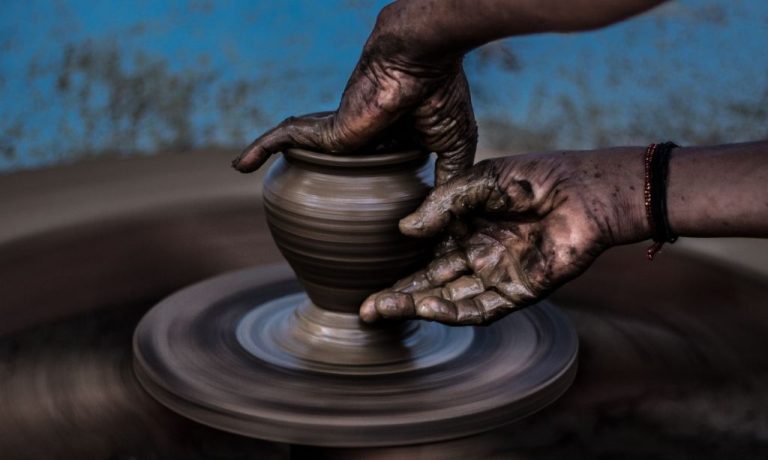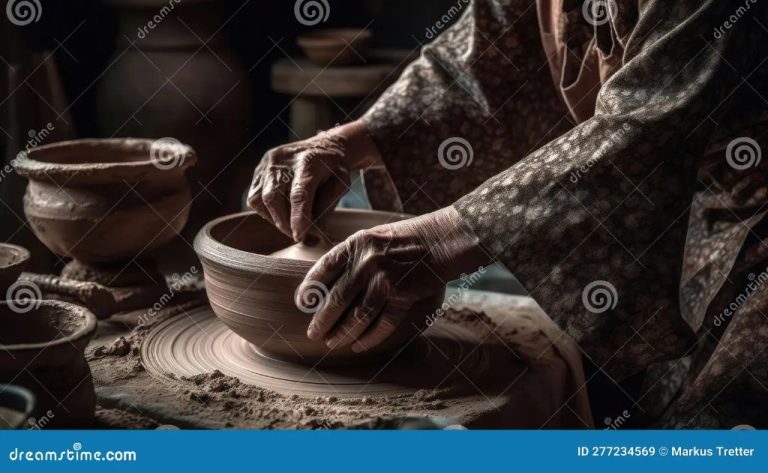Who Uses Clay To Make Pots?
Making pots from clay is an ancient craft that has been used by cultures around the world for thousands of years. Evidence suggests that pottery was first made in East Asia during the late Paleolithic period, with fragments of ceramic pots and figures discovered in China and Japan dating back to around 20,000 BCE. However, pottery existed even earlier than this – fragments of fired clay vessels discovered in Morocco have been dated to around 25,000 BCE.
Pottery then spread to other parts of Asia, Africa, and Europe. Some of the earliest known pottery comes from the Jomon period in ancient Japan (around 14,000-400 BCE), where communities used clay coils to create elaborate flame-shaped pots. In the ancient Middle East, pottery production began around 7,000 BCE as people started settling into agricultural communities. Ancient Egyptians began working with clay even earlier, fashioning figurines from Nile mud as early as 5,000 BCE.
As civilizations developed, pottery took on more uses and became an important technology. Ceramic pots were lighter and more portable than stone vessels, and could be formed into a variety of shapes and sizes. Pottery allowed people to store, transport, and cook food, leading to new agricultural and culinary advancements. Over time, pottery developed into an art form and potters perfected techniques like the potter’s wheel and glazing.
Today, pottery persists as both an ancient craft and a living art practiced around the world.
Types of Clay
Clay is the primary material used in pottery making. There are three main types of clay that are commonly used by potters: earthenware, stoneware, and porcelain.
Earthenware is a soft, porous type of clay that can be fired at lower temperatures. It absorbs water easily and is less durable than other clays. Earthenware can be glazed to provide a waterproof coating and decorative effects. Terracotta is a common type of earthenware.
Stoneware is stronger and less porous than earthenware due to higher firing temperatures. It resists water absorption and is durable for utilitarian and decorative use. The clay has a natural gray or brown color before firing and glazing. Common items made from stoneware include mugs, casseroles, and plates.
Porcelain is made from the purest clay and fired at extremely high temperatures. It is highly vitrified, non-porous, and very hard. Porcelain has a white color and translucent quality when thinly potted. It is popular for tableware and art objects. Bone china is a type of porcelain made with bone ash.
Tools and Techniques
Potters employ various tools and techniques to shape clay into functional or decorative pieces. The three main methods are wheel throwing, hand building, and molding.
Wheel Throwing
Wheel throwing involves using a potter’s wheel to form clay vessels with symmetry and uniform walls. As the wheel spins, the potter places a lump of clay in the center and uses their hands to shape it into the desired form. This takes coordination and practice to center the clay and raise the walls evenly. Wheel throwing allows creating uniform pieces like bowls, vases, cups, and plates.
Hand Building
Hand building involves manipulating the clay directly with the hands and simple tools like paddles and ribs. Techniques like pinch pots, coiling, and slab building give the artist more control over asymmetrical or organic shapes. Hand building allows creating unique pieces like sculptures, decorative tiles, and more intricate vessels.
Molding
Molding uses pre-shaped molds to form clay objects with uniformity and intricacy. The clay is pressed into a plaster, ceramic, or other mold then removed to retain the shape. Molding enables consistent reproduction of designs and detailed effects difficult to achieve otherwise. It’s commonly used for tiles, bricks, plates, and decorative objects.
Whether thrown on a wheel, built by hand, or cast in a mold, clay requires proper preparation and care to become a lasting creation. Mastering these fundamental techniques allows potters to craft beautiful and functional works in this ancient medium.
Famous Pottery Cultures
Pottery has been an important artform and tool across many ancient cultures around the world. Some of the most well-known pottery cultures include:
Greek Pottery
Ancient Greek pottery dates back over 5,000 years. Some of the most famous styles include the iconic black-figure and red-figure techniques. Distinctive Greek vessels like amphoras and kraters have been found across the Mediterranean. Greek pottery provides insights into daily life, mythology, and artistic styles in ancient Greece.
Chinese Pottery
China has a long pottery history stretching back over 10,000 years. Distinct styles emerged like Longquan celadon ware and Jingdezhen porcelain. Chinese potters developed innovative techniques like painted enamel. Chinese pottery often depicts historical scenes and natural elements like dragons. Fine Chinese porcelain was widely traded and inspired potters globally.
Japanese Pottery
Japanese ceramic traditions go back over 10,000 years. Distinct styles include Jōmon ware, Sue ware, and Arita porcelain. Japanese potters have mastered techniques like wood-firing, celadon glazing, and karatsu stoneware. Styles reflect aspects of Japanese culture and aesthetics. Japanese porcelain was initially influenced by Chinese imports then developed its own unique forms.
Native American Pottery
Native American pottery was developed independently across many tribes. Styles reflect local clay resources and cultural symbolism. Common techniques include coiling, scraping, burnishing, and pit firing. Well-known pottery styles include Hopi, Zuni, Santa Clara, Mimbres, Anasazi, and Pueblo wares. Native American pottery provides insights into pre-Columbian cultures and traditions.
Modern Potters
Today, there are two main types of potters that create clay pots and other ceramic wares – studio potters and production potters.
Studio potters are independent artists who handcraft pottery and sell directly to customers through their own studios, galleries, markets and online stores. They focus on making one-of-a-kind pieces or small batches of their original designs. Studio potters have the freedom to experiment with different clays, techniques, decorative styles, glazes and firing methods to produce unique works of art.
In contrast, production potters work for large manufacturing operations that mass produce pottery using molds, machines and assembly lines. Their goal is to efficiently replicate identical pieces in large quantities rather than create one-of-a-kind works. Production potters may focus on specialty tasks like throwing pots on the wheel, mold making, glazing, or operating kilns. The end products are sold through retailers and commercial outlets around the world.
While studio potters emphasize creativity and production potters focus on volume, both play an important role in making functional and artistic ceramic pieces available to consumers today.
Uses of Pottery
From ancient times to today, pottery has served a variety of important purposes for humans across many cultures. Here are some of the main uses of pottery that have stood the test of time:
Sculpture
One of the oldest uses of pottery is for creating sculptures. Prehistoric cultures produced simple figurines from clay that represented gods, people, animals, and other subjects. Pottery sculpture continued to develop as an art form in ancient Greece, China, Mesoamerica, and elsewhere. Today, ceramic sculptures still allow artists to render intricate 3D forms.
Tableware
Clay pottery has long been the material of choice for plates, bowls, cups, and other tableware items. Ceramic dishes are attractive, durable, and safe for serving food. Pottery vessels make up a large portion of the archaeological remains of ancient civilizations. And ceramic tableware continues to be ubiquitous in modern kitchens.
Storage
The durability and sealability of fired clay has made pottery vessels ideal for storing goods for thousands of years. From jars for grain storage in ancient Egypt to canning jars in pioneer days to cookie jars in modern homes, pottery has served a crucial storage role. Even liquid and semiliquid foods like wine, olive oil, and yogurt are still transported in ceramic amphorae and pots.
Pottery in Everyday Life
Pottery products play a vital role in our day-to-day lives. From cooking pots and mugs to flower vases and decorative items, fired clay vessels and dishes can be found in almost every home.
Clay pots have been used for cooking for thousands of years across many cultures. Unglazed terra cotta pots are still commonly used for cooking in many parts of the world today. Their porous nature allows steam to escape while cooking, preventing food from becoming overly soggy. Many chefs prefer cooking with clay pots due to even heat distribution. Cooking over a flame in a clay pot results in food that is moist and tender.
Ceramic mugs are ubiquitous drinking vessels found in most kitchens. While materials like glass or metal can also be used for cups and mugs, ceramic ones are valued for their ability to retain heat, as well as their durability. A variety of glazes and decorative patterns applied to mugs make them an attractive part of tableware.
Clay pots and vases have traditionally been used as containers for fresh cut flowers and dried floral arrangements. The variety of shapes, sizes, and colors available for ceramic vases and pots mean they can be used decoratively even when empty of flowers. Some pottery vases are considered works of art even without any contents.
This wide use of pottery for utilitarian and decorative purposes demonstrates that this ancient craft continues to be an integral part of daily domestic life today.
Pottery as Art
Ceramics have been considered an art form for thousands of years. While functional pottery was crucial for early civilizations, decorative ceramic artworks were also highly valued. Ancient Greek vessels were often painted with complex scenes, and Chinese porcelain was renowned for its delicate beauty.
Today, ceramics are exhibited in major art museums around the world. The Metropolitan Museum of Art in New York City has an extensive collection of ceramic art from diverse cultures. The Museum of Fine Arts in Boston also boasts a significant display of ceramics. In London, the Victoria and Albert Museum contains over 19,000 pieces of ceramic art in its collection.
Many contemporary artists also use clay as an artistic medium. Peter Voulkos helped elevate pottery to fine art in the U.S. during the mid-20th century. Magdalene Odundo is a British-Kenyan ceramicist known for her hand-built vessels inspired by African pots. Yeesookyung manipulates shards of broken porcelain into ethereal, biomorphic sculptures. Clearly, ceramics are now widely appreciated as more than functional objects, but as meaningful works of art.
Economics of Pottery
The pottery industry generates billions in revenue annually across the globe. According to market research, the global ceramic and pottery market was valued at around $300 billion in 2020. It’s projected to reach $460 billion by 2025. The industry includes everything from mass-produced tableware to unique handcrafted art pieces.
The top producing countries are China, India, Brazil, Thailand, Turkey, Indonesia, Iran, Spain, Italy, and Mexico. China dominates, accounting for over 70% of global ceramic output. Pottery remains an important part of local economies and cultural heritage in many developing regions too.
In the US, pottery sales were over $5 billion in 2018. American potters sell locally at craft shows, galleries, studios, and online. Imports make up the majority of ceramics sold. Major US producers include American Artstone, Dal Tile, Kohler, and Mission Clay Products.
Unlike other industries, pottery has resisted automation and mass production. While factories churn out cheap pots, handmade pieces remain popular for their uniqueness and artistry. Small operations thrive serving niche markets. Overall, the continued global demand for pottery products points to a strong future for this ancient craft.
Future of Pottery
The future of pottery looks bright as new technologies open up exciting possibilities while maintaining the craft’s rich history. Sustainability is also becoming increasingly important.
3D printing allows potters to rapidly prototype and produce intricate designs that were once very difficult to make. This expands the creative possibilities. Recycled and eco-friendly clays are also gaining popularity as potters aim to reduce their environmental impact.
Social media enables potters to directly connect with customers worldwide. This provides more opportunities to make a living from pottery. Online video tutorials also make it easier to teach and learn pottery skills.
While technology is transforming pottery, interest in traditional techniques persists. Handcrafted pots made locally on a wheel or coiled by hand have an appeal that machine-made items lack. Passing down time-honored methods also connects to rich cultural heritage.
Overall, blending modern innovations with age-old wisdom promises an engaged community of potters and collectors who keep the tradition thriving. The universal human creative urge to shape clay into functional art will endure into the future.




